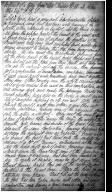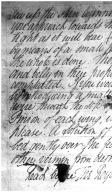[ To Preserve Birds with Their Natural Plumage Unhurt ] Dr. William James Almon
Date: 1770/03/21
Source:
Manuscript Notebook of Dr. William James Almon
Institution: Nova Scotia Archives
| Source Origin: Almon Family Fonds
| Reference: MG 1 / Microfilm Reel 10,045
Instructions for taxidermy focusing specifically on preserving birds, pp. 73-74. Though Almon's source is uncertain, the excerpt is from a letter addressed to John Ellis from Capt. Davies read before the Royal Society and published in A Manual of Useful Knowledge compiled by William Pybus (Hull: William Rawson, 1810), pp. 132-33.
Extract of a letter from Capt. Davies R. A. to John
Ellis Esqr F. R. S. __
“Let a bird, beast or any such like production of Nature
be procured, and that has been well preserved in its
death, either naturally or by shot, Let the Bird be open
-ed from the upper part of the breast to the vent, with
a sharp knife or a pair of scissors, the feathers of the
Breast and belly being first carefully laid aside by the
fingers, so as not to hinder the skin from being come at
easily-- The skin must then be carefully loosened from
all the fleshy parts of the breast, body, thighs and wings
then cut out all the flesh from those parts, and take out
also all the entrails and all the inside; then having
got a composition of burnt alum, camphire, cinnamon
of each equal parts well powdered, and mixt together
strew some of this powder over the whole carcase, but
salt is by no means to be used in this composition, as it
will always drop, and make the plumage Nasty in
moist weather, pour also in the body a small quan
-tity of camphor dissolved in Sp. vin. rect. After that
fill up the cavity, with fine cotton, or any other soft
woolen substance, pouring some of the aforesaid spirit
into the cotton or stuffing -- Open next the mouth, with
a pair of scissors take away the tongue, the roof of the
mouth, Eyes, brains, and inside of the head, fill that
also with the same Composition; having procured Eyes
as near the natural ones as possible (Beeds will
be found the best) put them into the sockets by
means of a pr. of pincers_ introduced at the mouth
Fill the head quite full of cotton, pouring some of the
Spirits down the throat with some of the powder, a
small piece of brass wire, that has been heated in the
fire to make it pliable may be put down the
throat, having pass’d thro’ one of the nostrils and
fastened to the breast bone. Place the head in any
altitude you please. Next fill up the body where
the flesh has been taken away, with cotton and your
composition, and having a fine needle and silk,
sew
sew up the skin beginning at the breast; observing as
you approach towards the vent, to stuff the skin as
tight as it will bear |this will be easiest accomplished
by means of a small piece of stick or ivory skewer,| till
the whole is done. Then lay the Feathers of the breast
and belly in their proper order--and your bird will be
compleated. If you would chuse to put it in an attitude
by introducing a small piece of the above mentioned
wire through the sole of each foot, up the Leg & into the
Pinion of each wing, it may be disposed of as you
please. A solution of Merc. corros. subl. in water, rub
-bed gently over the feathers will prevent insects or
other vermin from destroying then Plumage
Read before The Royal Society March 21.st 1770. -- Vol. LX
Download: Transcription | Images

